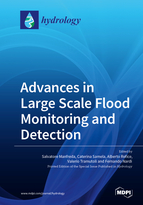Advances in Large Scale Flood Monitoring and Detection
A special issue of Hydrology (ISSN 2306-5338). This special issue belongs to the section "Hydrological and Hydrodynamic Processes and Modelling".
Deadline for manuscript submissions: closed (30 June 2018) | Viewed by 72691
Special Issue Editors
Interests: stochastic processes; hydrological modelling; model calibration; flood risk; geomorphology; ecohydrology; UAS monitoring
Special Issues, Collections and Topics in MDPI journals
Interests: flood hazard and risk; geomorphology, surface hydrology; automated pattern recognition; scarce data environments; large scales; Geographic Information System
Special Issues, Collections and Topics in MDPI journals
Interests: processing of remotely sensed data, with emphasis on synthetic aperture radar (SAR) and SAR interferometry (InSAR); applications of remote sensing to the retrieval of information about the Earth surface and to the monitoring of environmental hazards
Interests: satellite remote sensing; robust satellite techniques for natural; environmental and industrial risks forecast and monitoring: floods, forest fires, earthquakes, volcanic eruptions, sand storms, air and water pollution, oil spills and energetic pipelines accidents
Special Issues, Collections and Topics in MDPI journals
Interests: regional planning and sustainability; hazard and risk mapping and management; citizen science and public engagement; open geo data and big data; hydrology; natural hazards; GIS; geospatial data
Special Issues, Collections and Topics in MDPI journals
Special Issue Information
Dear Colleagues,
The last decades have seen a massive increase in new technologies for Earth observation (EO) and environmental monitoring, which provided scientists and engineers with valuable spatial information for studying hydrologic processes. At the same time, the power of computers and newly-developed algorithms have grown sharply.
Such advances have extended the range of possibilities for hydrologists, which are trying to exploit at the most these potentials, updating and re-inventing the way hydrologic and hydraulic analyses are carried out. A variety of research fields have progressed significantly, ranging from the evaluation of water features, to the classification of land-cover, the identification of river morphology, and the monitoring of extreme flood events.
In particular, the description of flood processes may particularly benefit from the coupled use of recent algorithms or data. In fact, flood exposure and risk over large areas and in scarce data environments has always been a challenging topic due to the limited information available on river basin hydrology, basin morphology, land cover and model uncertainty. The ability of new tools to carry out intensive analysis over huge datasets allows to produce flood studies over larger and larger extent and with a growing level of detail.
The challenge of this Special Issue is to describe the state-of-the-art on flood studies using innovative methods and identify the frontier of this research branch. The Special Issue is dedicated to contributions focusing on the benefit of the use of new algorithms, new measurements systems and EO data for flood assessment, monitoring, and management. The research presented might focus on:
-
New methods and technologies for river morphology monitoring;
-
Innovative methods for flood mapping over large areas;
-
Use of open/big data in hydrologic modelling of floods;
-
Advanced applications of EO and UAS data for hazard, vulnerability, risk mapping, and post-disaster recovery phase;
-
Innovative applications in support to disaster risk reduction strategies;
-
Development of tools and platforms for assessment and validation of hazard/risk models.
-
The special issue is intended to explore the potential of different types of sensors (e.g., thermal, visual, radar, laser, and/or the fusion of these) and algorithms for the prediction of extreme events and emergency management.
Prof. Dr. Salvatore Manfreda
Dr. Caterina Samela
Dr. Alberto Refice
Prof. Dr. Valerio Tramutoli
Prof. Dr. Fernando Nardi
Guest Editors
Manuscript Submission Information
Manuscripts should be submitted online at www.mdpi.com by registering and logging in to this website. Once you are registered, click here to go to the submission form. Manuscripts can be submitted until the deadline. All submissions that pass pre-check are peer-reviewed. Accepted papers will be published continuously in the journal (as soon as accepted) and will be listed together on the special issue website. Research articles, review articles as well as short communications are invited. For planned papers, a title and short abstract (about 100 words) can be sent to the Editorial Office for announcement on this website.
Submitted manuscripts should not have been published previously, nor be under consideration for publication elsewhere (except conference proceedings papers). All manuscripts are thoroughly refereed through a single-blind peer-review process. A guide for authors and other relevant information for submission of manuscripts is available on the Instructions for Authors page. Hydrology is an international peer-reviewed open access monthly journal published by MDPI.
Please visit the Instructions for Authors page before submitting a manuscript. The Article Processing Charge (APC) for publication in this open access journal is 1800 CHF (Swiss Francs). Submitted papers should be well formatted and use good English. Authors may use MDPI's English editing service prior to publication or during author revisions.
Keywords
-
Hydroinformatics
-
Flood Mapping
-
Flood Monitoring
-
Floodplains
-
Rivers Dynamics
-
DEM-based methods
-
Geomorphology
-
Data scarce environment










